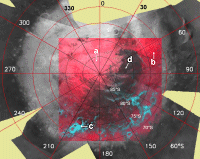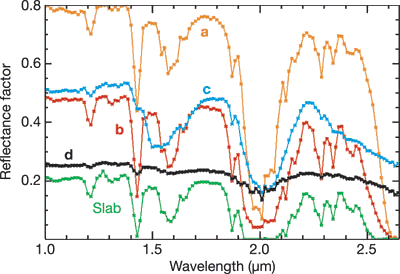OMEGA Measurements of Southern Polar Cap
27 October 2006
The polar caps on Mars consist chiefly of CO2 and exhibit seasonal variations in their coverage. Observations by the OMEGA instrument are challenging current theories on the nature of one particular region of the southern polar cap known as the cryptic region.The Thermal Emission Spectrometer instrument on the Mars Global Surveyor spacecraft first revealed the cryptic region during observations of the surface temperature and albedo in 1997 and defined it as a region that remained cold long after its albedo reached a value similar to that for the exposed Martian surface. To account for this observation, Kieffer et al. proposed (in 2000) that a solid slab of translucent CO2 ice covered the surface in this region (accounting for the lower temperature) and that the low albedo came from the underlying surface.
 |
|
Figure 1: Composite image of ten OMEGA strips over Mars's south pole at 1.08 μm. |
Spectral analysis of the OMEGA data can reveal several characteristics:
- the mean path of photons in the icy material (transparency) is derived from relative depths of the absorption bands
- the average grain size of the CO2 ice
- amount of dust and H2O-ice inclusions in the CO2 ice
The main finding from these new observations is that the cryptic region shows very weak signatures of CO2 ice – a measurement that is not consistent with the current theory. In order to understand more fully the cryptic region OMEGA scientists ran computer simulations to determine the combination of CO2 ice, water ice and dust that would be necessary to meet the new result.
Their conclusion is that an ice slab, at least 0.1 m deep exists over the surface, but the top few cm in the upper layer is heavily contaminated by dust. There are two possible sources for this dust:
- The first is from the atmosphere and the storms associated with the nearby Hellas basin.
- The second is from the formation of a series of features, known as spots, spiders and fans, which are formed when sub-ice gas bubbles, produced as the solar radiation passing through the slab warms the surface below, erupt bringing dust up through the ice layer to the surface.


